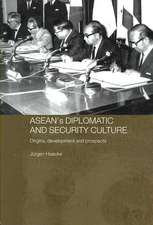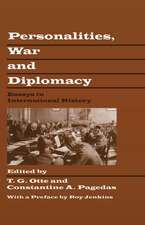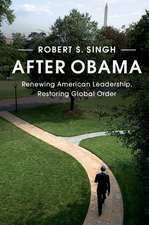Contagion and War: Lessons from the First World War
Autor John A. Vasquezen Limba Engleză Paperback – 21 noi 2018
| Toate formatele și edițiile | Preț | Express |
|---|---|---|
| Paperback (1) | 260.86 lei 3-5 săpt. | |
| Cambridge University Press – 21 noi 2018 | 260.86 lei 3-5 săpt. | |
| Hardback (1) | 648.69 lei 6-8 săpt. | |
| Cambridge University Press – 21 noi 2018 | 648.69 lei 6-8 săpt. |
Preț: 260.86 lei
Nou
Puncte Express: 391
Preț estimativ în valută:
49.94€ • 52.11$ • 41.86£
49.94€ • 52.11$ • 41.86£
Carte disponibilă
Livrare economică 19 februarie-05 martie
Preluare comenzi: 021 569.72.76
Specificații
ISBN-13: 9781108404273
ISBN-10: 1108404278
Pagini: 412
Ilustrații: 27 b/w illus. 15 tables 80 exercises
Dimensiuni: 153 x 228 x 21 mm
Greutate: 0.68 kg
Editura: Cambridge University Press
Colecția Cambridge University Press
Locul publicării:Cambridge, United Kingdom
ISBN-10: 1108404278
Pagini: 412
Ilustrații: 27 b/w illus. 15 tables 80 exercises
Dimensiuni: 153 x 228 x 21 mm
Greutate: 0.68 kg
Editura: Cambridge University Press
Colecția Cambridge University Press
Locul publicării:Cambridge, United Kingdom
Cuprins
Part I. Theoretical Expectations: 1. Contagion processes in the First World War; 2. Research design; Part II. Dyadic Case Analyses: History and Data: 3. 1914: the local war and the first wave; 4. 1915–16: the second wave; 5. 1917: the third wave; Part III. Conclusions: Lessons from the First World War: 6. The neutrals; 7. How contagion actually worked.
Recenzii
'Some scholars like to look at forests from the outside-in and never get too close to the trees. Others like to plunge into the forest and tag every tree. Despite the old adage of not seeing the forest for the trees, both approaches can prove profitable. John A. Vasquez's latest book is a tree-tagging exercise that pays off in generating an inside-out look at why war participation spreads. There is still more to learn about these contagious processes but tackling first one of the toughest nuts to crack in the war inventory, World War I, should make it easier to figure out why wars spread in general. And just when you thought everything had been said about World War I that could be said, Vasquez comes up with some new twists on how things worked between 1914 and 1918.' William R. Thompson, Distinguished and Rogers Professor Emeritus, Indiana University
'Contagion and War is a nuanced and systematic exploration of the multiple causal processes through which war might spread, illustrated by a detailed examination of the First World War. Vasquez makes a significant contribution to both the theory of international conflict and to our historical understanding of one of the world's most catastrophic and consequential wars.' Jack S. Levy, Rutgers University, New Jersey
'Contagion and War adds to our knowledge of World War I and multiparty conflicts … by recognizing that temporal sequences are involved in both the start and spread of belligerency, and teasing out and exploring the mechanisms associated with them.' Richard Ned Lebow, War in History
'Contagion and War is a nuanced and systematic exploration of the multiple causal processes through which war might spread, illustrated by a detailed examination of the First World War. Vasquez makes a significant contribution to both the theory of international conflict and to our historical understanding of one of the world's most catastrophic and consequential wars.' Jack S. Levy, Rutgers University, New Jersey
'Contagion and War adds to our knowledge of World War I and multiparty conflicts … by recognizing that temporal sequences are involved in both the start and spread of belligerency, and teasing out and exploring the mechanisms associated with them.' Richard Ned Lebow, War in History
Notă biografică
Descriere
Explains how war spreads through an original analysis of the contagion that brought countries into the First World War.

















